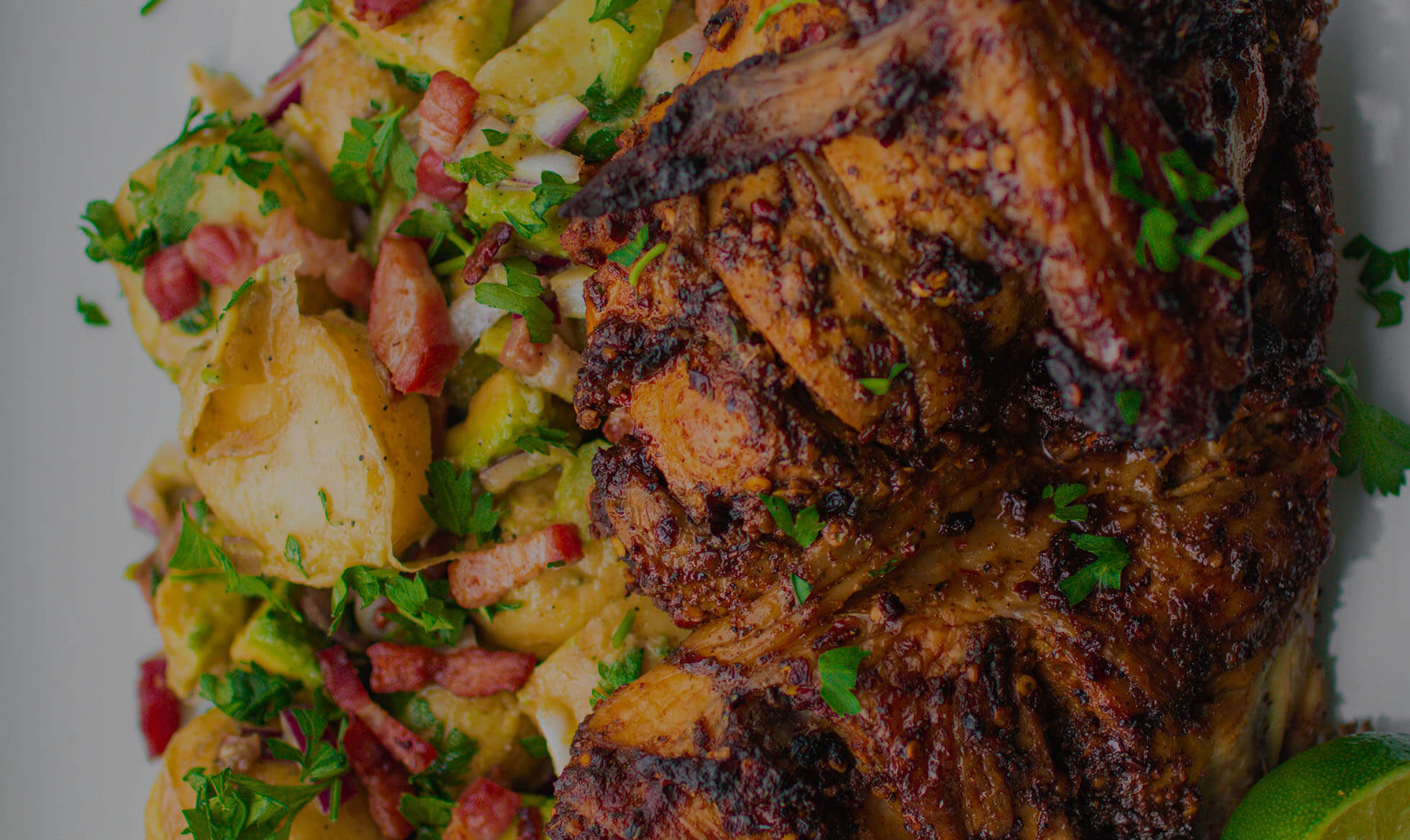

Turkey
Buyer's Guide


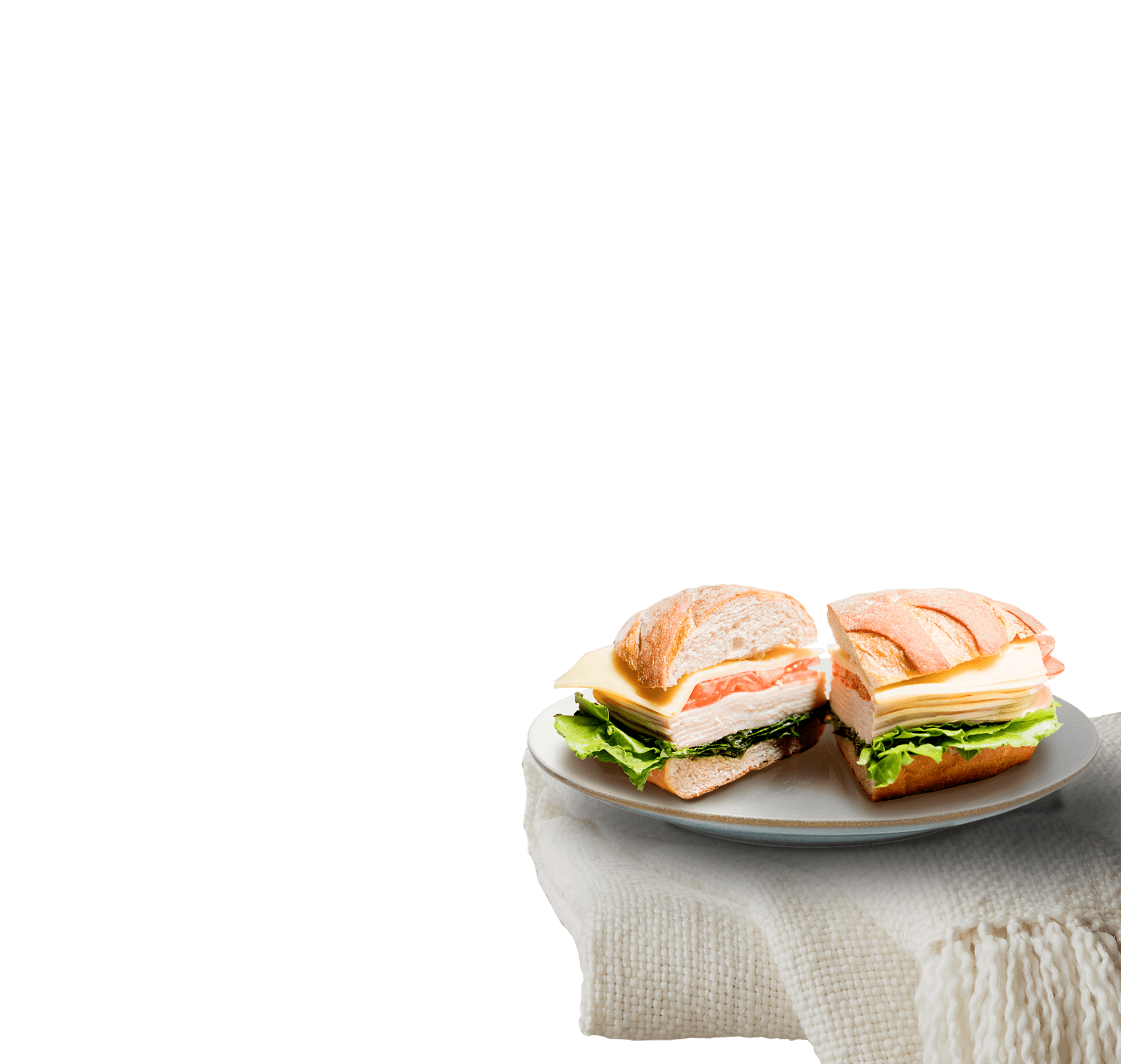
U.S. Turkey
Popular & Versatile
Turkey is one of the most popular meats due to its high protein content, range of health benefits, and great taste. Turkey meat boasts a versatile range of applications. Roasted whole turkeys are traditionally served during North American holidays, turkey cold cuts are popular in delicatessens, and turkey dishes are found on the menus of fine restaurants the world over.
High quality turkey meat has several health benefits. Turkey is high in protein and low in cholesterol and saturated fat, which makes for a hearty, healthy meal. Turkey is also a good source of niacin, tryptophan, and vitamins B6 and B12. Eating turkey has benefits for people of all ages and lifestyles.
Beyond its health benefits, versatility in dishes, and excellent flavor, turkey meat is a great value in consumer, food service, and commercial applications.
Turkey is one of the most popular meats due to its versatility, range of health benefits, and great taste.
Turkey is high in protein and low in cholesterol and saturated fat, which makes for a hearty, healthy meal. Turkey is also a good source of niacin, tryptophan, and vitamins B6 and B12.
Beyond its health benefits, versatility, and excellent flavor, turkey meat is a great value in consumer, food service, and commercial applications.
United States turkey companies that are members of the USA Poultry and Egg Export Council (USAPEEC) make up over 95 percent of U.S. turkey production. Because U.S. turkey is renowned for its high quality, these companies market turkey and turkey products to more than 90 countries around the world.
United States turkey companies that are members of the USA Poultry and Egg Export Council (USAPEEC) make up over 95 percent of U.S. turkey production. Because U.S. turkey is renowned for its high quality, these companies market turkey and turkey products to more than 90 countries around the world.
USAPEEC member companies slaughter and process U.S. turkeys in establishments that are meticulously inspected by the United States Department of Agriculture’s (USDA) Food Safety and Inspection Service (FSIS). These highly qualified inspectors ensure that each turkey produced in these facilities meet the stringent U.S. food safety requirements. USDA certified turkey is guaranteed to be high quality.
USAPEEC member companies slaughter and process U.S. turkeys in establishments that are meticulously inspected by the USDA's Food Safety and Inspection Service (FSIS).
These highly qualified inspectors ensure that each turkey produced in these facilities meet the stringent U.S. food safety requirements. USDA certified turkey is guaranteed to be high quality.
The USDA Mark of Inspection certifies that turkey and turkey products have been properly processed and are certified as fit for human consumption. The USDA grade shield indicates quality, and most U.S. turkey meat receives Grade A. Grade A indicates that turkeys are meaty and plump, have smooth skin that is free of bruising, have no broken bones, and are not missing flesh.
The USDA Mark of Inspection certifies that turkey and turkey products have been properly processed and are certified as fit for human consumption. The USDA grade shield indicates quality, and most U.S. turkey meat receives Grade A. Grade A indicates that turkeys are meaty and plump, have smooth skin that is free of bruising, have no broken bones, and are not missing flesh.
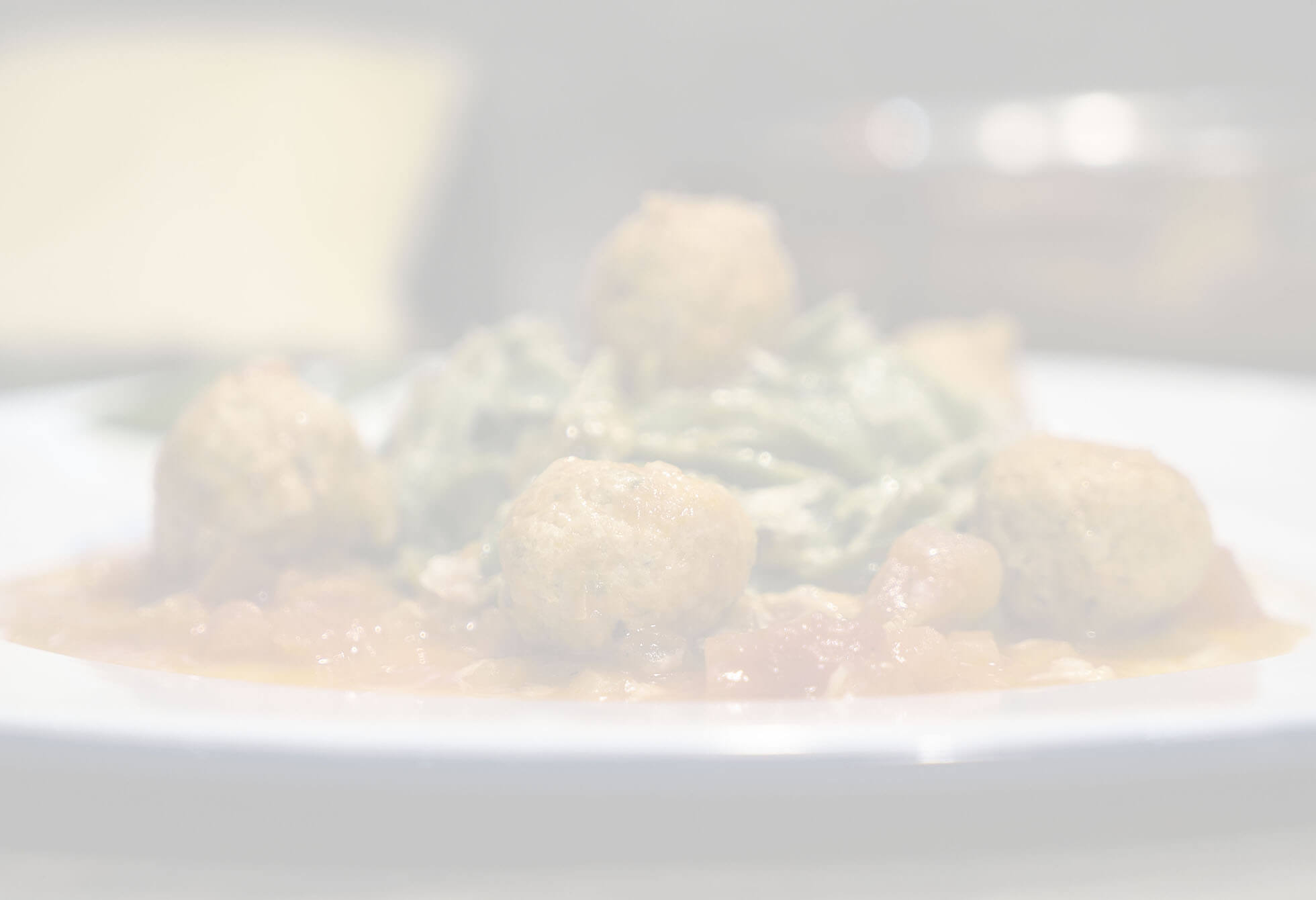


Quality Inspection
Food safety is the highest priority among USA Poultry and Egg Export Council (USAPEEC) member companies. Plants that slaughter and process U.S. turkeys are subject to stringent poultry inspection requirements enforced by the U.S. Department of Agriculture’s (USDA) Food Safety and Inspection Service (FSIS).
Food safety is the highest priority among USA Poultry and Egg Export Council (USAPEEC) member companies. Plants that slaughter and process U.S. turkeys are subject to stringent poultry inspection requirements enforced by the U.S. Department of Agriculture’s (USDA) Food Safety and Inspection Service (FSIS).
Under careful observation of a USDA inspector, turkeys are bled, de-feathered, and eviscerated. The head and feet are also removed at this step. In addition, turkeys may be slaughtered according to Halal or Kosher specifications.
Within eight hours of slaughter, the temperature of each turkey carcass is reduced to 40°F (4.4°C) or colder. Temperature is carefully monitored and maintained throughout shipping, processing, and handling. After slaughter, turkeys are ready either for market as a whole bird or for further processing.
Under careful observation of USDA inspectors, turkeys are bled, de-feathered, and eviscerated. The head and feet are also removed. Turkeys may be slaughtered according to Halal or Kosher requirements. Within 8 hours of slaughter, carcass temperature is reduced to 40°F (4.4°C) or colder, and carefully monitored throughout each step.
On site food preparation is a complex process that carries the possibility of exposure to harmful contaminants or pathogens. For this reason, the turkey and turkey product preparation process should always follow these guidelines:
- All food handlers should maintain strict sanitary personal hygiene.
- Precautions should be taken to minimize handling of all products before, during, and after preparation.
- Procedures should be established to ensure continuous sanitary food handling.
- All food handlers must strictly adhere to proper handling, cooking, and reheating procedures.
- Cooked turkey or turkey products should never be stored near raw, uncooked turkey.
1. All food handlers should maintain strict sanitary personal hygiene.
2. Handling of product should be minimized before, during, & after preparation.
3. Procedures should be established to ensure continuous sanitary food handling.
4. All handlers must adhere to proper handling, cooking, & reheating procedures.
5. Cooked products should never be stored near raw, uncooked turkey.
Hazard Analysis Critical Control Point (HACCP) is a procedure that seeks to identify and control the points in processing at which contamination can occur. Since HACCP food safety systems are designed to accommodate specific plant requirements, the process design varies from plant to plant.
Hazard Analysis Critical Control Point (HACCP) is a procedure that seeks to identify and control the points in processing at which contamination can occur. Since HACCP food safety systems are designed to accommodate specific plant requirements, the process design varies from plant to plant.
Step One: Identify hazards in the food processing system.
Example: Bacteria
Step Two: Identify critical control points at which potential hazards can be eliminated or reduced in the processing channel.
Example: Cleaning, cooking, chilling, handling, and storage
Step One: Identify hazards in the food processing system.
Step Two: Identify critical control points at which potential hazards can be eliminated or reduced in the processing channel.
Step Three: Establish preventive measures with critical limits for each control point.
Example: Time and temperature are examples of critical limits. Poultry must be chilled to 40°F (4.4°C) during processing to prevent bacteria from growing. In this case, 40°F (4.4°C) would be the critical limit.
Step Four: Establish procedures to monitor the control points.
Example: Where temperature has been identified as a critical limit, product samples would be checked at fixed intervals to ensure that the temperature is within the critical limit.
Step Three: Establish preventive measures with critical limits for each control point.
Step Four: Establish procedures to monitor the control points.
Step Five: Establish procedures for taking corrective actions when monitoring indicates that a critical limit has not been met.
Example: Take steps to lower the temperature in the chiller.
Step Six: Establish effective record keeping to document the HACCP system.
Example: Regarding temperature monitoring, records would be kept of temperature measurements and the corrective action taken if applicable.
Step Five: Establish procedures for taking corrective actions when monitoring indicates that a critical limit has not been met.
Step Six: Establish effective record keeping to document the HACCP system.
Step Seven: Establish procedures to certify that monitoring equipment is always effective.
Example: On temperature monitoring, the temperature gauges would be tested at fixed intervals to ensure that they are working properly.
Step Seven: Establish procedures to certify that monitoring equipment is always effective.

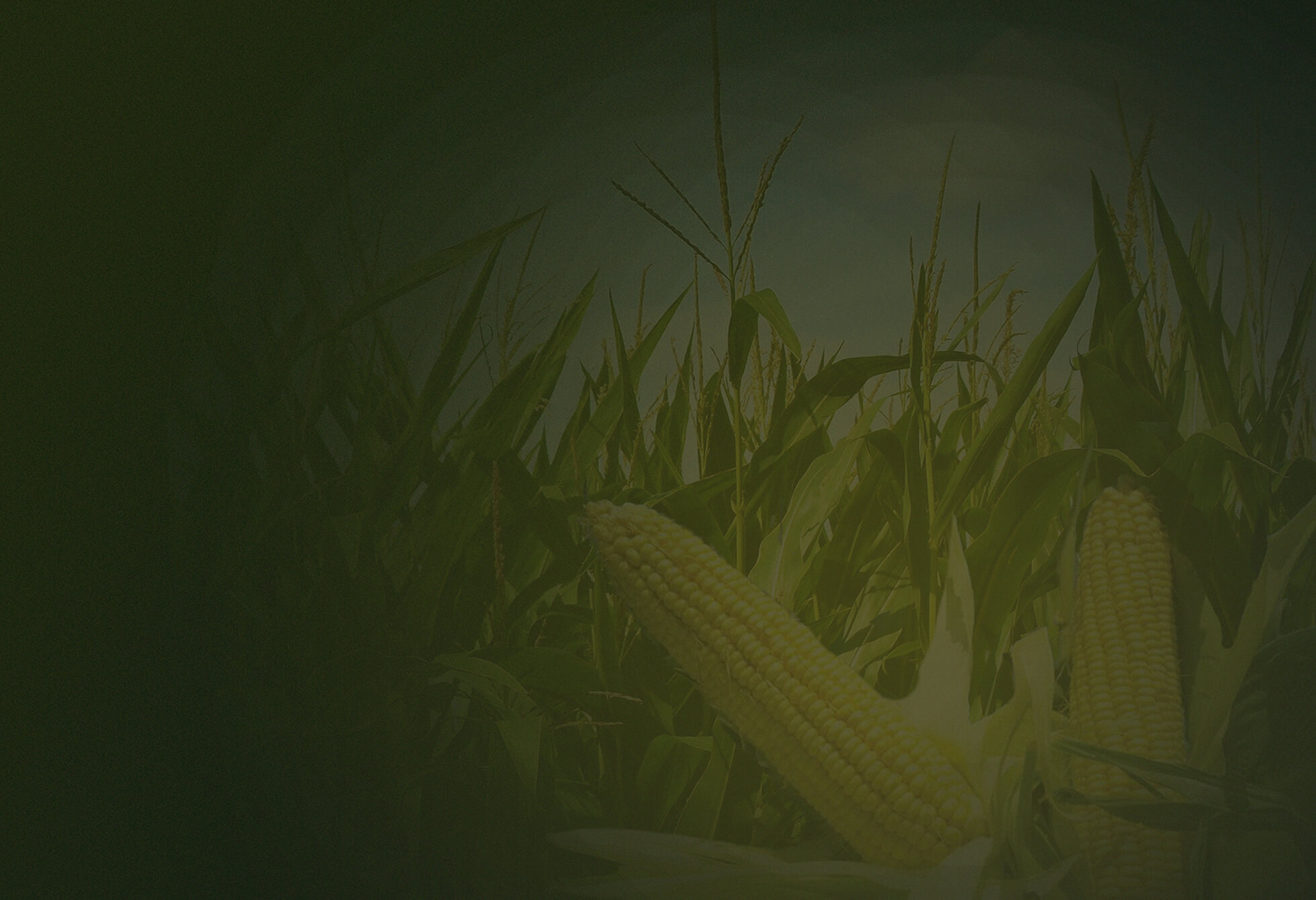


Classifications
Young Turkeys
Young turkeys are typically slaughtered for use in poultry products when they are four to six months old. Both young turkey hens (females) and toms (males) may be sold whole and ready-to-cook. Young turkey hens weigh 8 to 16 pounds (3.7 to 7.3 kilograms), whereas young tom turkeys weigh from 16 to 40 pounds (7.3 to 18.2 kilograms).
Mature Turkeys
Mature turkeys are typically spent breeder hens that are mechanically deboned, and not sold whole. Mature turkey meat may be used in products such as turkey bologna, frankfurters, and a variety of other processed turkey meats.
Young turkeys are typically slaughtered for use in poultry products when they are four to six months old. Young turkey hens weigh 8 to 16 pounds (3.7 to 7.3 kilograms), whereas young tom turkeys weigh from 16 to 40 pounds (7.3 to 18.2 kilograms).
Mature turkeys are typically spent breeder hens that are mechanically deboned, and not sold whole. This turkey meat may be used in turkey bologna, frankfurters, and other processed meats.

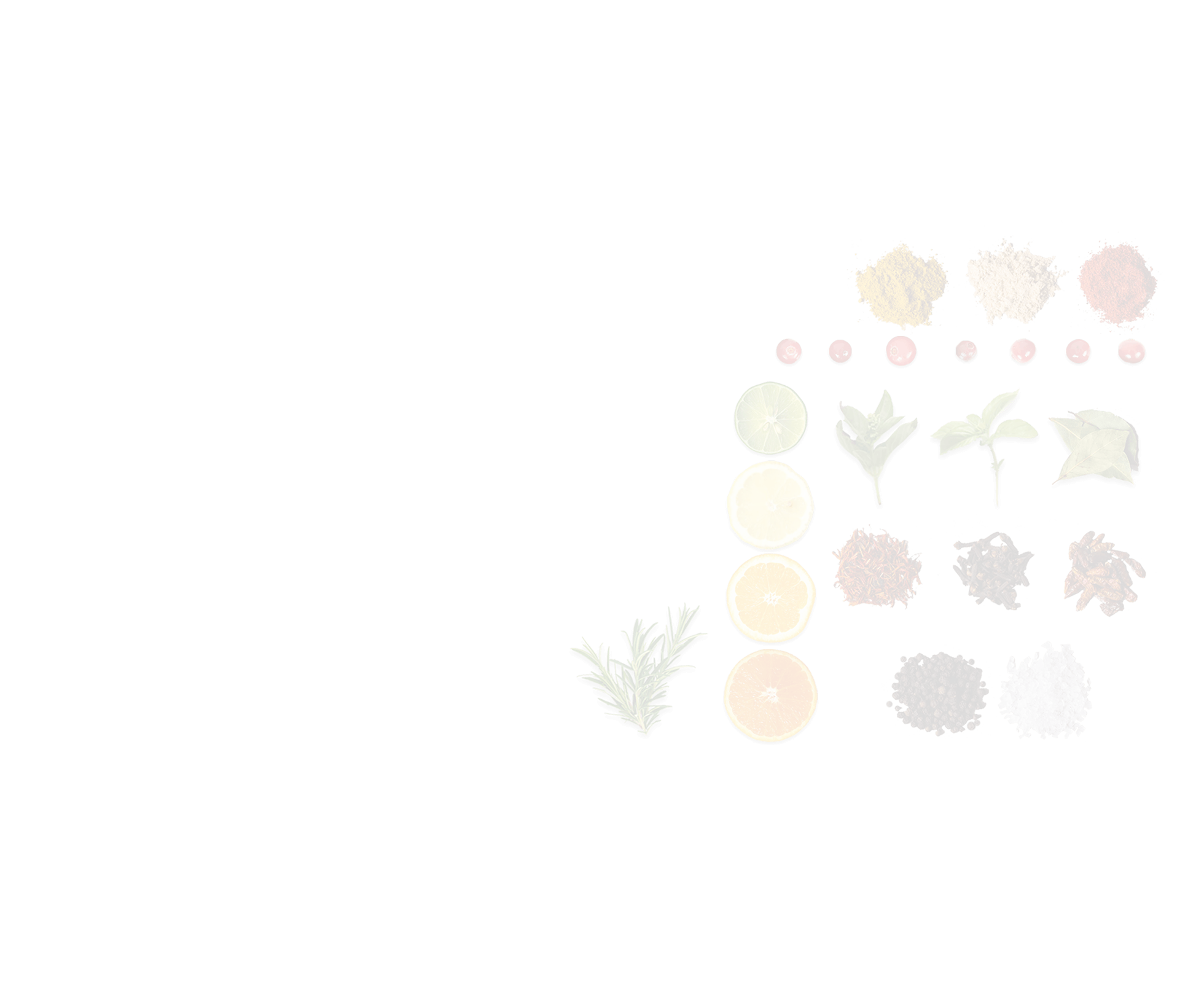

Uncooked
Turkeys classified as “whole” leave the processing plant in fresh or frozen form and may be graded. Fresh turkeys may or may not be wrapped, while frozen whole turkeys are usually packaged. A giblet pack (gizzard, heart, liver, and neck) is generally included with each whole turkey, though if the turkey is packaged without these parts, it may be labeled “WOGS” (without giblets).
Young fresh or frozen whole turkeys weigh from 8 to 40 pounds (3.6 to 18.1 kilograms). It is optional to designate the packaged turkey as a hen or tom, however when it is indicated in the labeling, it refers to size rather than quality or tenderness. Fresh and frozen whole turkeys may be basted to enhance moisture and tenderness. Whole turkeys that are not basted are often sold as “natural” turkeys.
Turkeys classified as “whole” leave the processing plant fresh or frozen and may be graded. A giblet pack (gizzard, heart, liver, and neck) is generally included with each whole turkey. Whole turkeys weigh 8 to 40 pounds (3.6 to 18.1 kilograms). It is optional to designate the packaged turkey as a hen or tom. Whole turkeys may be basted to enhance tenderness.
To produce this cut, the whole bone-in breast is removed from the carcass at the junction of the vertebral ribs and the backbone, which contains the pectoralis major and pectoralis minor muscles. The bone-in turkey breast is all white meat. Bone-in turkey breasts with ribs are marketed in fresh or frozen forms.
Whole bone-in breasts may be sold in retail packages weighing 4, 6, or 8 pounds (1.8, 2.7, or 3.6 kilograms), and in institutional packages weighing 8 to 20 pounds in 2 pound increments (3.6 to 9.1 kilograms in 0.9 kilogram increments).
The whole bone-in breast is removed from the carcass at the junction of the vertebral ribs and the backbone. This cut is all white meat. Whole bone-in breasts may be sold in retail packages weighing 4, 6, or 8 pounds (1.8, 2.7, or 3.6 kilograms), and in institutional packages weighing 8 to 20 pounds in 2 pound increments (3.6 to 9.1 kilograms in 0.9 kilogram increments).
Turkey tenderloin is a highly tender cut of boneless, skinless white meat. Turkey tenderloin comes from the pectoralis minor muscle and is cut from the inside of the breast adjacent to the keel bone. Turkey tenderloins are marketed as fresh or frozen, and weigh between 6 to 16 ounces (170 to 454 grams).
Turkey tenderloin is a highly tender cut of boneless, skinless white meat. Turkey tenderloin comes from the pectoralis minor muscle and is cut from the inside of the breast adjacent to the keel bone. Turkey tenderloins are marketed as fresh or frozen, and weigh between 6 to 16 ounces (170 to 454 grams).
Turkey drumsticks comprise the portion between the knee joint and the hock, or the lower portion of the leg quarter. Turkey drumsticks are all dark meat and come bone-in without the tendons removed. Typically, turkey drumsticks are sold with the skin on, which consumers particularly enjoy cooked to a crisp. Bone-in drumsticks weigh from one half to 2 pounds (0.2 to 0.9 kilograms).
Turkey drumsticks comprise the portion between the knee joint and the hock, or the lower portion of the leg quarter. Turkey drumsticks are all dark meat and come bone-in without the tendons removed. Typically, turkey drumsticks are sold with the skin on. Bone-in drumsticks weigh from one half to 2 pounds (0.2 to 0.9 kilograms).
This portion is produced by separating the thigh of the turkey from the drumstick with a cut at the knee and from the backbone at the joint. The thigh of the turkey is all dark meat. Bone-in turkey thighs with the skin on weigh from one half to 2.5 pounds (0.2 to 1.13 kilograms). Turkey thighs are also sold boneless and skinless.
This portion is produced by separating the thigh of the turkey from the drumstick with a cut at the knee and from the backbone at the joint. The thigh of the turkey is all dark meat. Bone-in turkey thighs with the skin on weigh from one half to 2.5 pounds (0.2 to 1.13 kilograms). Turkey thighs are also sold boneless and skinless.
More turkey thigh meat is sold boneless than is sold bone-in. Thigh meat is typically used by meat processors as an ingredient in manufacturing further processed products. Boneless turkey thigh meat is usually sold in 40 pound (18 kilogram) bulk packages.
More turkey thigh meat is sold boneless than is sold bone-in. Thigh meat is typically used by meat processors as an ingredient in manufacturing further processed products. Boneless turkey thigh meat is usually sold in 40 pound (18 kilogram) bulk packages.
Boneless turkey roasts, or boneless whole turkeys, are usually marketed frozen. They sometimes come encased in skin and netting for easier roasting. The roast is comprised of both white and dark meat in natural proportions.
For retail sale, the roast generally weighs 3 to 5 pounds (1.36 to 2.3 kilograms). For institutional and food service sale, roasts weigh approximately 9 to 14 pounds (4.1 to 6.4 kilograms).
Boneless turkey roasts, or boneless whole turkeys, are usually marketed frozen. The roast is comprised of both white and dark meat in natural proportions. For retail sale, the roast generally weighs 3 to 5 pounds (1.36 to 2.3 kilograms). For institutional and food service sale, roasts weigh approximately 9 to 14 pounds (4.1 to 6.4 kilograms).
Whole turkey wings are composed of three sections, cut from the carcass at the shoulder joint. The whole turkey wing is all white meat. While they are a popular comfort food in the Southern United States, whole turkey wings may be baked, roasted, braised, or prepared in a variety of other ways. Whole turkey wings weigh between one half and 2 pounds (0.23 and 0.9 kilograms).
Whole turkey wings are composed of three sections, cut from the carcass at the shoulder joint. The whole wing is all white meat. While they are a popular comfort food in the Southern U.S., whole turkey wings may be baked, roasted, or prepared in numerous other ways. Whole turkey wings weigh between one half and 2 pounds (0.23 and 0.9 kilograms).
Turkey wing parts usually comprise the two-joint portion at the flat middle section of the wing and the wing tip, however it may also refer to the drumette and the middle section of the wing.
Turkey wing parts usually comprise the two-joint portion at the flat middle section of the wing and the wing tip, however it may also refer to the drumette and the middle section of the wing.
Turkey necks are marketed without skin. The neck may be sold on its own, or as a part of the giblet package that also contains the gizzard, heart, and liver.
Turkey necks are marketed without skin. The neck may be sold on its own, or as a part of the giblet package that also contains the gizzard, heart, and liver.
This product includes the complete turkey thigh and drumstick, with half the rear back portion attached. The turkey’s tail may be attached in some cases. Hind quarters are all dark meat. This portion weighs from 2 to 5 pounds (0.9 to 2.3 kilograms).
This product includes the complete turkey thigh and drumstick, with half the rear back portion attached. The turkey’s tail may be attached in some cases. Hind quarters are all dark meat. This portion weighs from 2 to 5 pounds (0.9 to 2.3 kilograms).
Turkey tails are a dark meat cut that has had the preen gland removed. Turkey tails may be sold fresh or frozen. Turkey tails are commonly packaged in bulk containers that weigh 20 to 30 pounds (9.1 to 13.6 kilograms).
Turkey tails are a dark meat cut that has had the preen gland removed. Turkey tails may be sold fresh or frozen. Turkey tails are commonly packaged in bulk containers that weigh 20 to 30 pounds (9.1 to 13.6 kilograms).
Turkey gizzards, hearts, and livers are high in protein and vitamins, and they have a variety of applications. These uncooked turkey parts are generally sold in bulk containers that weigh between 20 and 30 pounds (9.1 to 13.6 kilograms).
Turkey gizzards, hearts, and livers are high in protein and vitamins, and they have a variety of applications. These uncooked turkey parts are generally sold in bulk containers that weigh between 20 and 30 pounds (9.1 to 13.6 kilograms).
Ground turkey meat can include white meat, dark meat, or a mixture of the two. Ground turkey meat is marketed in a variety of fresh and frozen forms. For the retail market, ground turkey meat is generally sold fresh in tray packs, or frozen in 1 to 10 pound (0.45 to 4.5 kilogram) tubes or chubs. It is commonly used like ground beef or pork.
Ground turkey is also sold in bulk as an ingredient used to manufacture processed products such as sausages, patties, nuggets, and deli loaves.
Ground turkey meat can include white meat, dark meat, or a mixture of the two. Ground turkey meat is marketed in a variety of fresh and frozen forms. For the retail market, ground turkey meat is generally sold fresh in tray packs, or frozen in 1 to 10 pound (0.45 to 4.5 kilogram) tubes or chubs. It is commonly used like ground beef or pork.
Ground turkey is also sold in bulk as an ingredient used to manufacture processed products such as sausages, patties, nuggets, and deli loaves.
Mechanically Separated Turkey (MST) is used as an ingredient in the manufacturing of a wide range of further processed turkey products, such as turkey hams, frankfurters, and other deli meats. MST is widely used as a less expensive alternative to pork. This product may also be sold as “mechanically de-boned meat” or “mechanically de-boned turkey meat.”
MST is generally bulk packaged in 40 pound (18 kilogram) round, poly-lined containers. It may also be sold in waxed or lined cardboard boxes.
Mechanically Separated Turkey (MST) is used as an ingredient in the manufacturing of a wide range of further processed turkey products, such as turkey hams, frankfurters, and other deli meats. MST is widely used as a less expensive alternative to pork. This product may also be sold as “mechanically de-boned meat” or “mechanically de-boned turkey meat.”
MST is generally bulk packaged in 40 pound (18 kilogram) round, poly-lined containers. It may also be sold in waxed or lined cardboard boxes.
Ready to cook and ready to be customized. Perfect for carving stations, catering and more. Add your favorite glaze or rub before cooking and prepare for the mouthwatering aroma of freshly roasted turkey to fill your operation.
Ready to cook and ready to be customized. Perfect for carving stations, catering and more. Add your favorite glaze or rub before cooking and prepare for the mouthwatering aroma of freshly roasted turkey to fill your operation.
The drumette is the first section of the turkey wing, cut between the shoulder joint and the elbow. Drumettes are all white meat. Turkey drumettes weigh about 1 pound (0.45 kilograms).
The drumette is the first section of the turkey wing, cut between the shoulder joint and the elbow. Drumettes are all white meat. Turkey drumettes weigh about 1 pound (0.45 kilograms).
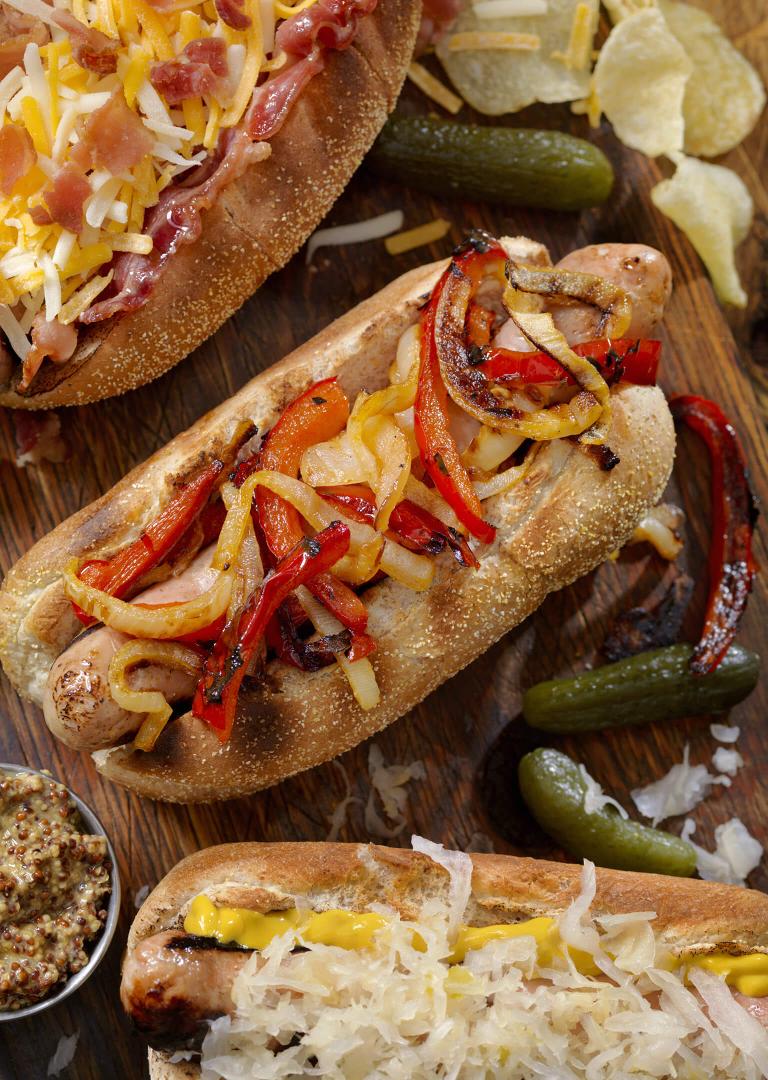
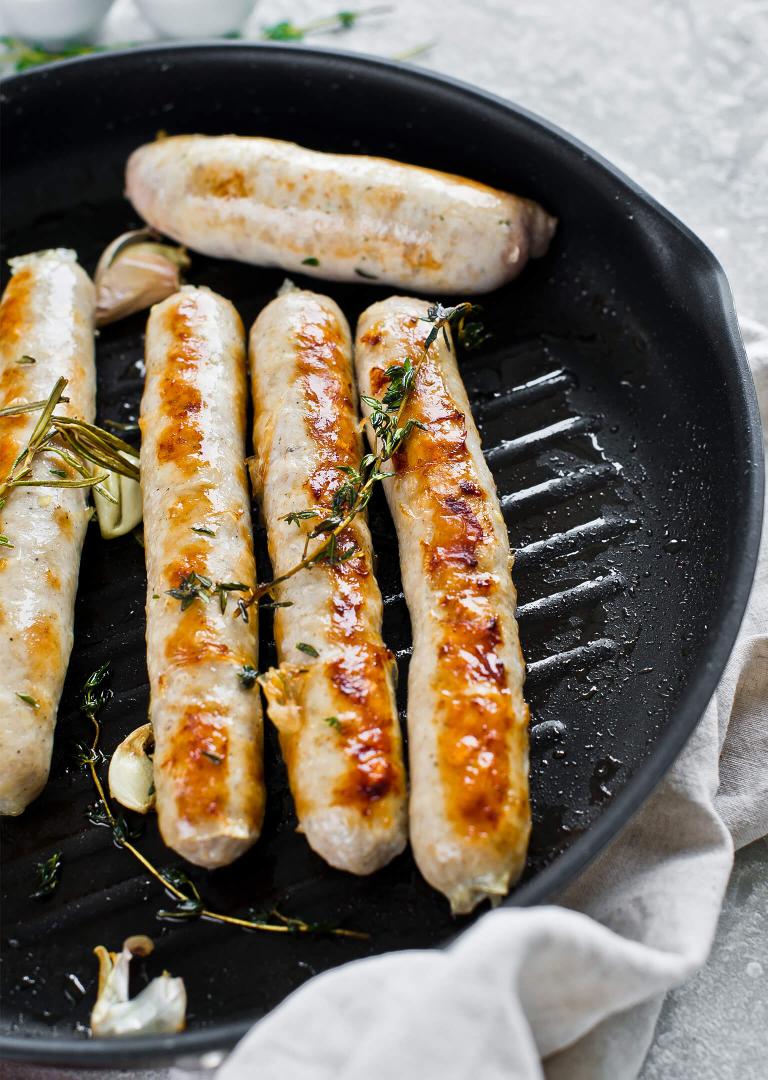
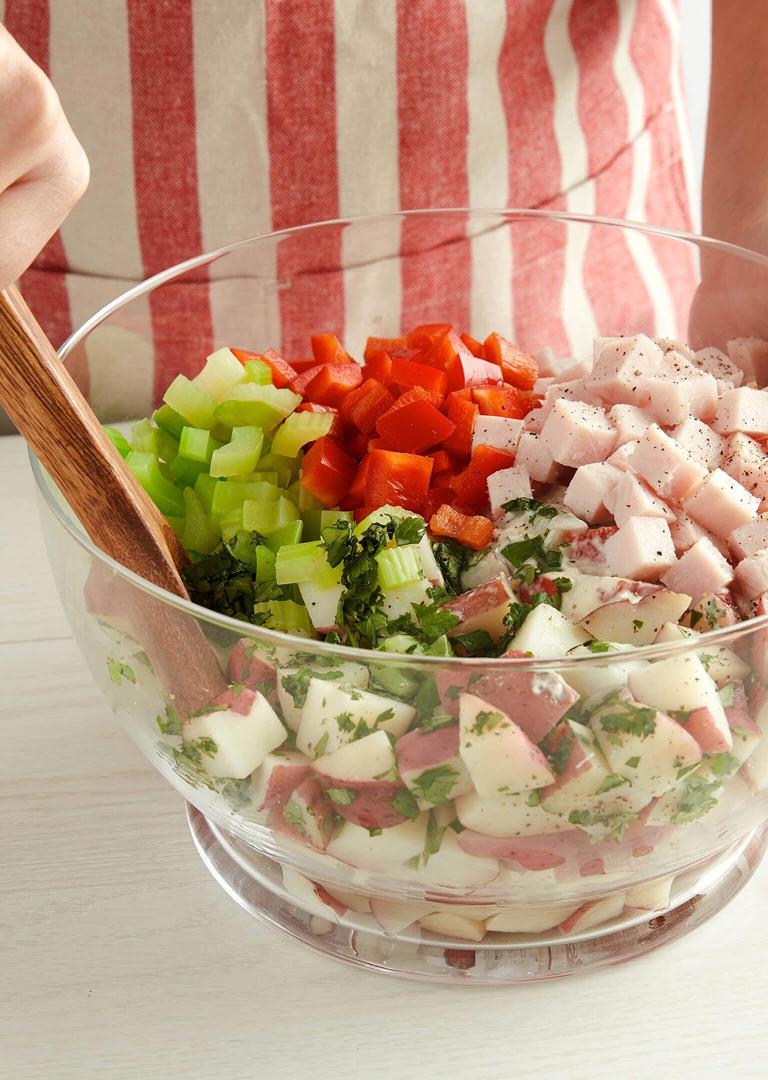



Processed
Turkey frankfurters are also known as “franks” or “hot dogs.” A blend of light and dark meat that has been mechanically separated goes into turkey frankfurters. These products are seasoned, cured, smoked, and peeled. Turkey hotdogs are often favored for their lower fat content over conventional hot dogs.
Turkey frankfurters are packaged at 8 or 10 franks per pound, or in larger packs for institutional uses.
Turkey frankfurters are also known as “franks” or “hot dogs.” A blend of light and dark meat that has been mechanically separated goes into frankfurters. These products are seasoned, cured, smoked, and peeled. Turkey hot dogs are often favored for their lower fat content over conventional hot dogs. Turkey frankfurters are packaged at 8 or 10 franks per pound, or in larger packs for institutional uses.
Turkey sausage can have significantly fewer calories than other sausage varieties, and turkey sausage is also often up to 50% lower in fat, making it a sensible choice for consumers. Turkey sausage also conforms to dietary standards of various religions that would not consume products made from other meats. Turkey sausage is made from a blend of light and dark meat.
It is available in several varieties, such as breakfast, Italian, Polish, smoked, or summer. Turkey sausage is also available raw or fully cooked. This product may be sold in bulk tray packs, links, or tubes.
Turkey sausage can have significantly fewer calories than other sausages, and has up to 50% less fat. It also conforms to dietary standards of religions that would not eat other meat products. This product is a blend of light and dark meat. It is available raw or uncooked in several varieties, such as smoked, summer, or Polish. This product may be sold in bulk tray packs, links, or tubes.
Diced turkey cubes range in size from one quarter to one half inch (0.635 to 1.25 centimeters), and are cut from all white meat, all dark meat, or mixed white and dark meat turkey rolls. This processed turkey product is generally packed in 5 to 10 pound (2.2 to 4.5 kilogram) bags, and may be used from the bag in salads, soups, or as a snack.
Diced turkey cubes range in size from one quarter to one half inch (0.635 to 1.25 centimeters), and are cut from all white meat, all dark meat, or mixed white and dark meat turkey rolls. This processed turkey product is generally packed in 5 to 10 pound (2.2 to 4.5 kilogram) bags, and may be used from the bag in salads, soups, or as a snack.
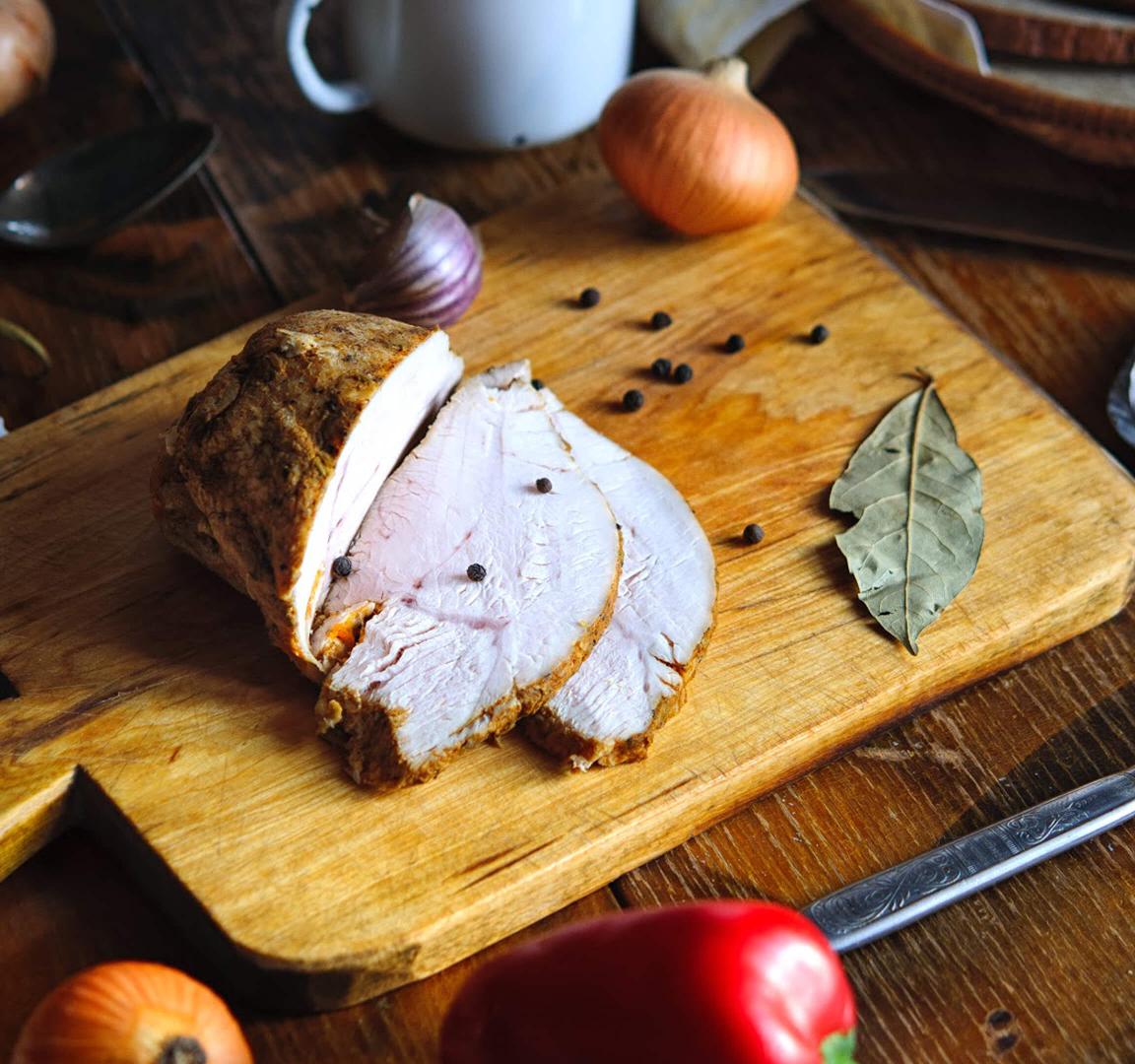
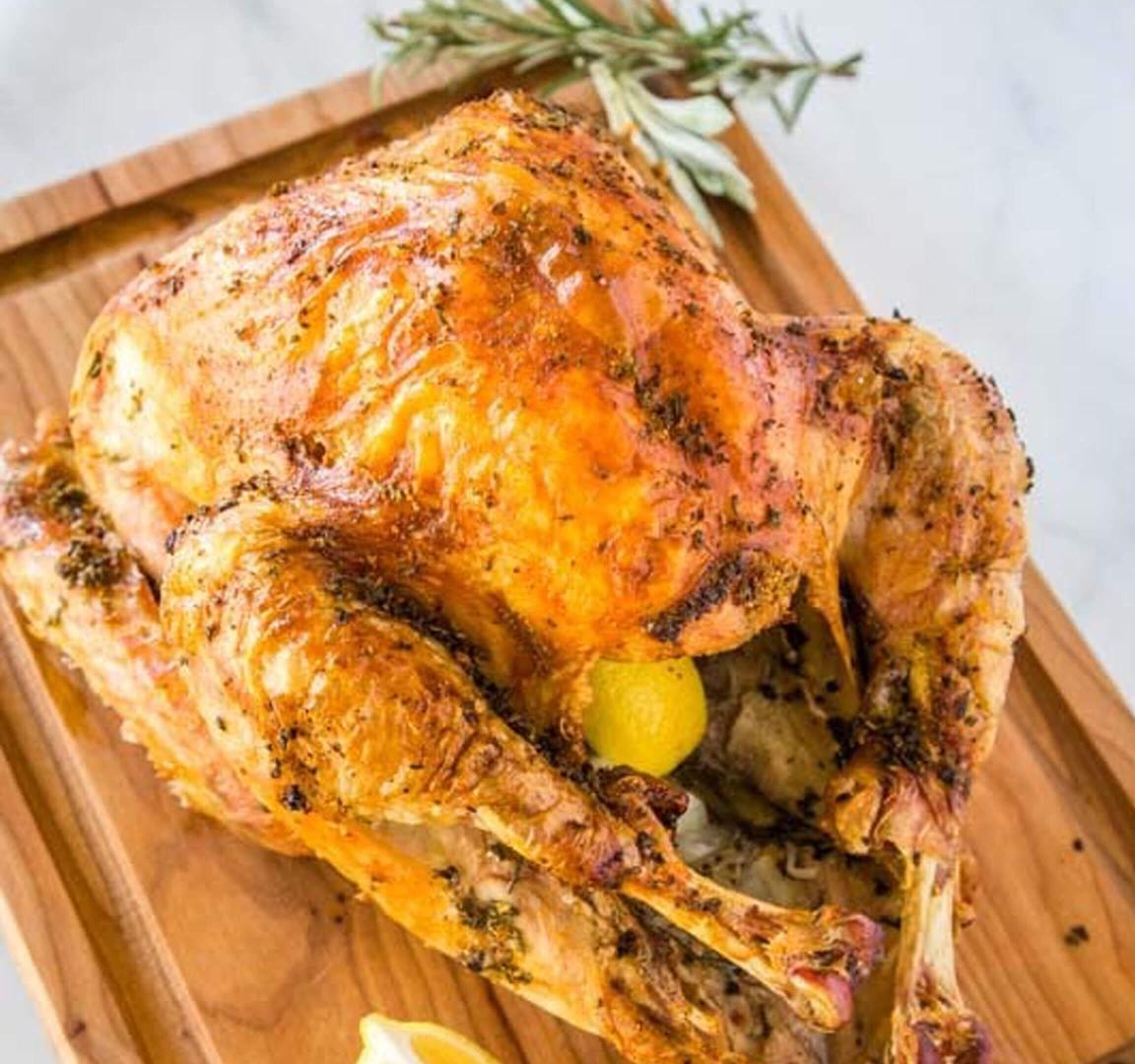
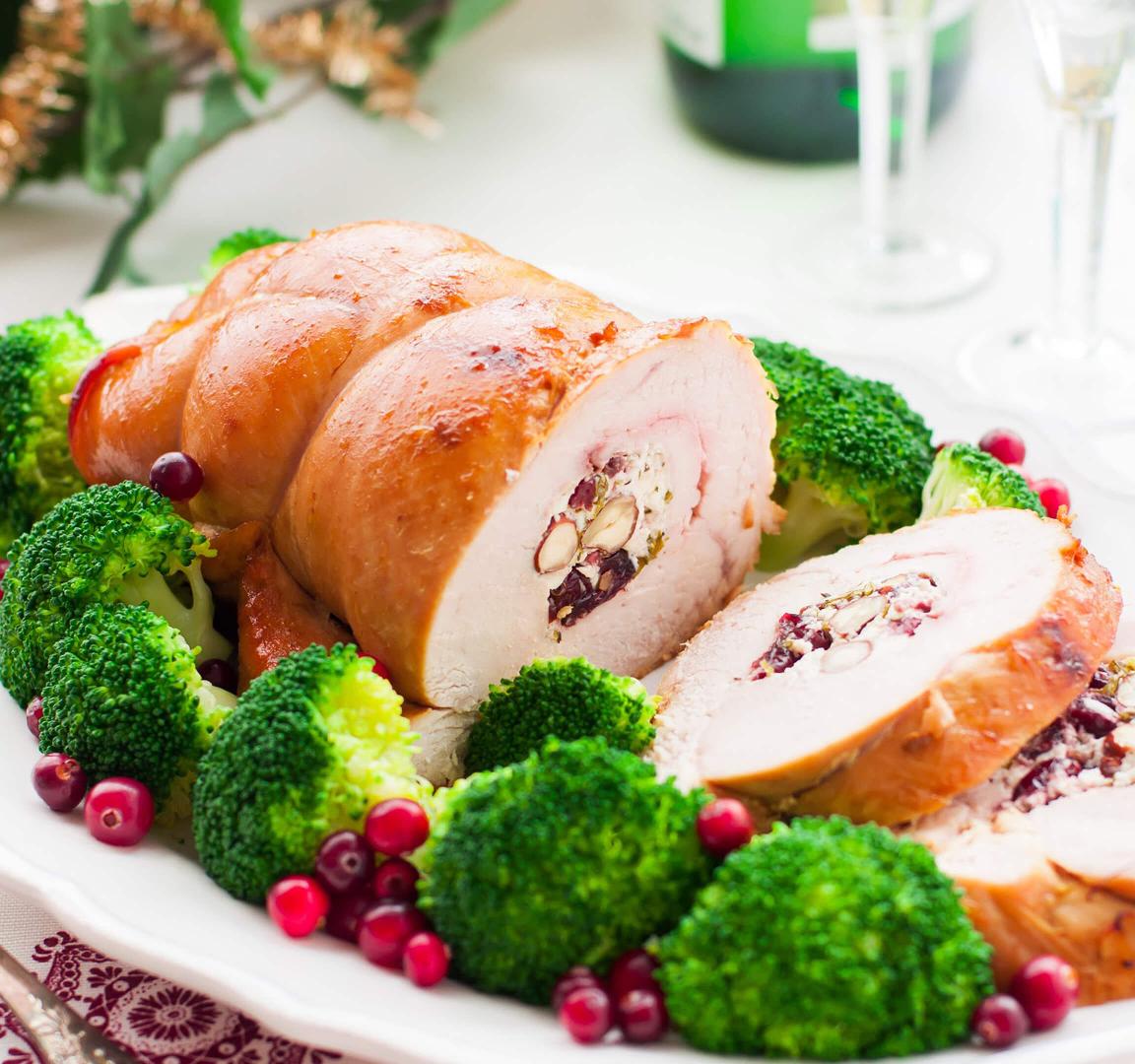



Prepared
Cooked turkey breast is marketed both skinless as well as skin on. Cooked turkey breast is available barbecued, oven roasted, smoked, and in many other flavors. Consumers particularly love skinless turkey breasts as a quick, easily prepared meal.
A whole, fully cooked turkey breast weighs approximately 8 to 10 pounds (3.6 to 4.5 kilograms). Half breasts are also available and weigh 4 to 5 pounds (1.8 to 2.2 kilograms). Cooked turkey breasts offer a wide range of hot and cold uses, including salads, sandwiches, or an array of entrees. The prices of cooked turkey breasts vary depending upon content and application.
Three categories of cooked turkey breasts are:
- Premium, whole muscle breasts for center of the plate applications;
- Mid range breasts from large breast chunks for general usage; and
- Lower end multi piece breasts for shaving applications.
Cooked turkey breast is marketed both skinless as well as skin on. It is available barbecued, oven roasted, smoked, and in many other flavors. A whole, fully cooked turkey breast weighs approximately 8 to 10 pounds (3.6 to 4.5 kilograms). Half breasts weigh 4 to 5 pounds (1.8 to 2.2 kilograms). The prices of cooked turkey breasts vary depending upon content.
Whole, fully cooked turkeys are ready to heat and eat. They are available smoked, roasted, and baked. Customers especially love smoked whole turkeys for their rich, wood fired flavor, without the need for a full outdoor smoker, or the time and labor required to smoke a turkey.
Cooked turkeys come marketed in a plastic bag that includes labeling. Whole cooked turkeys typically weigh 6 to 16 pounds (2.7 to 7.3 kilograms).
Whole cooked turkeys are ready to heat and eat. They are available smoked, roasted, and baked. Customers especially love smoked whole turkeys for their rich, wood fired flavor, without the time and labor required to smoke a turkey. Cooked turkeys are marketed in plastic bags that include labeling. These turkeys typically weigh 6 to 16 pounds (2.7 to 7.3 kilograms).
Cooked turkey rolls are made from all white meat, or as a mixture of 60% white meat and 40% dark meat. Turkey breast rolls are an especially popular product. Turkey rolls can be sliced up for cold cuts and salads, or rolls may be heated as an entrée.
Cooked turkey rolls are made from all white meat, or as a mixture of 60% white meat and 40% dark meat. Turkey breast rolls are an especially popular product. Turkey rolls can be sliced up for cold cuts and salads, or rolls may be heated as an entrée.
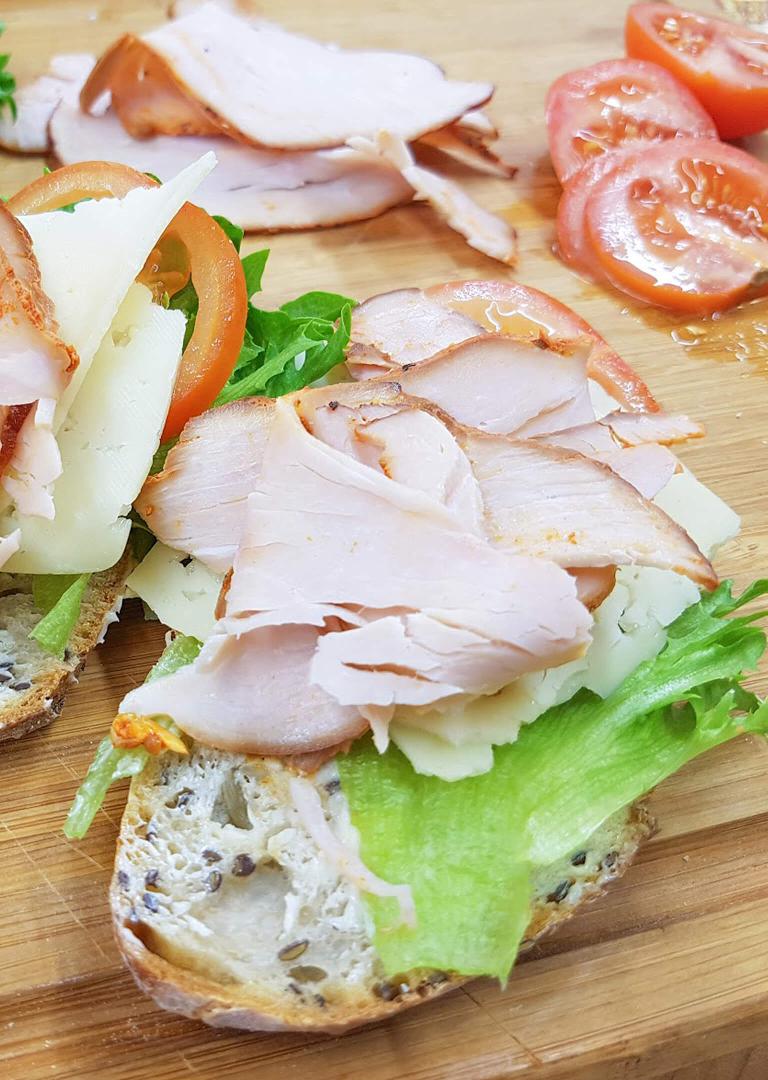
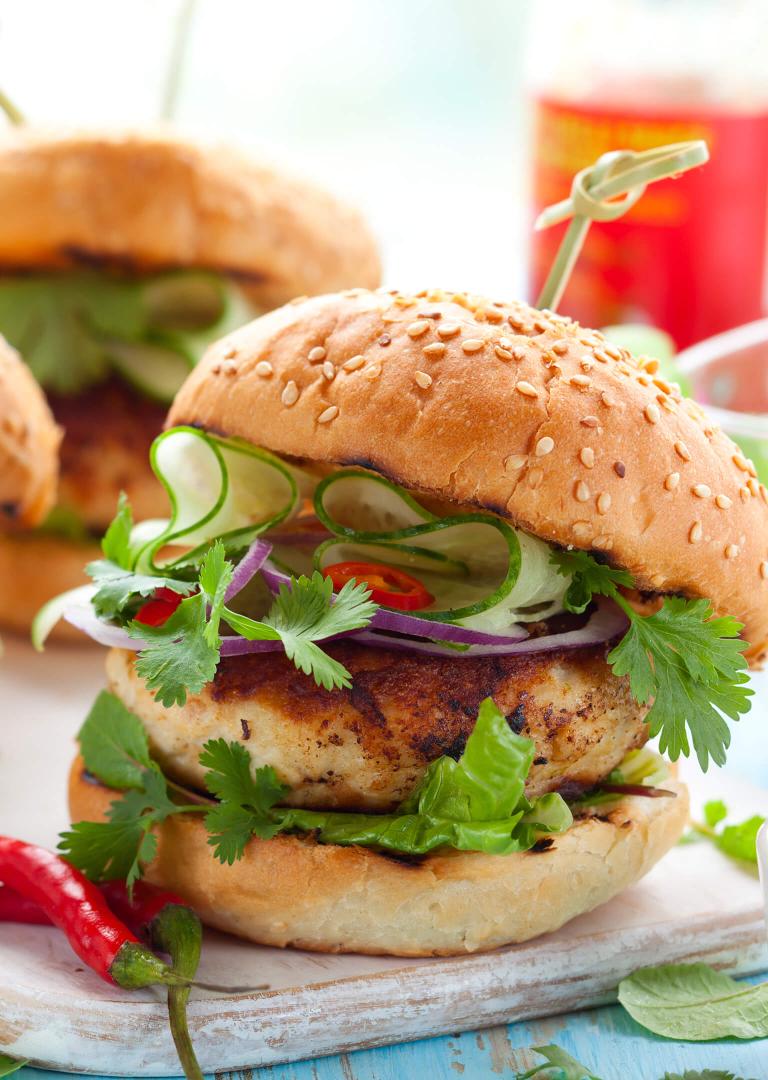
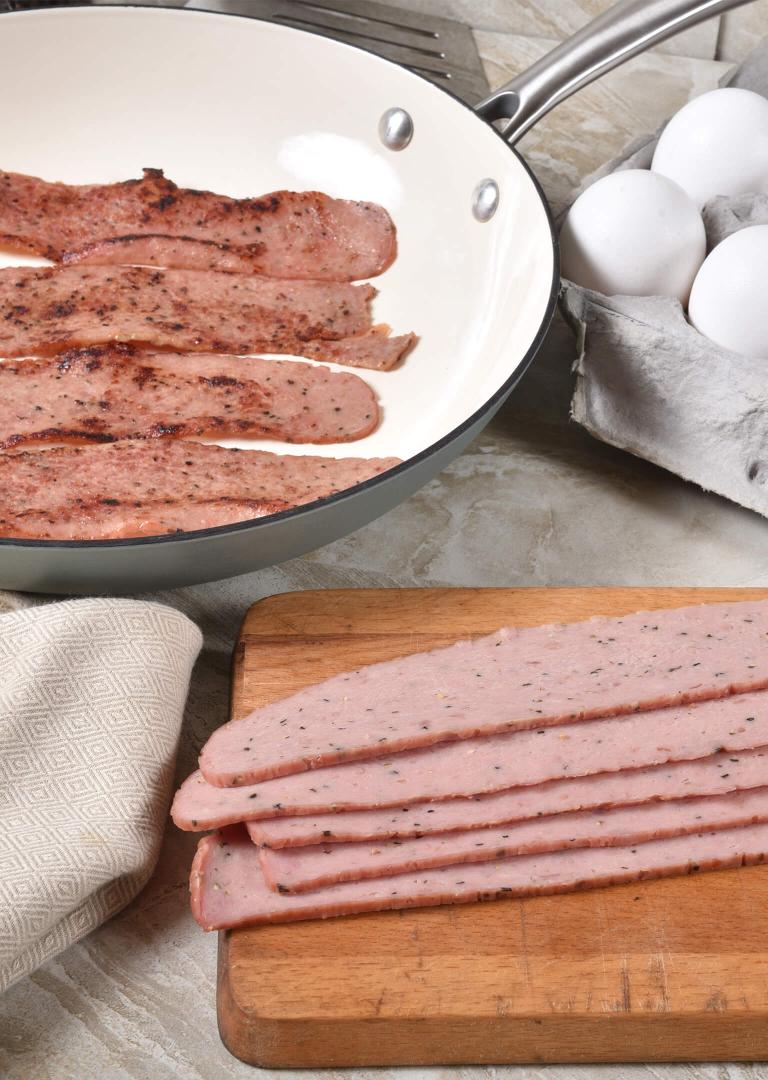
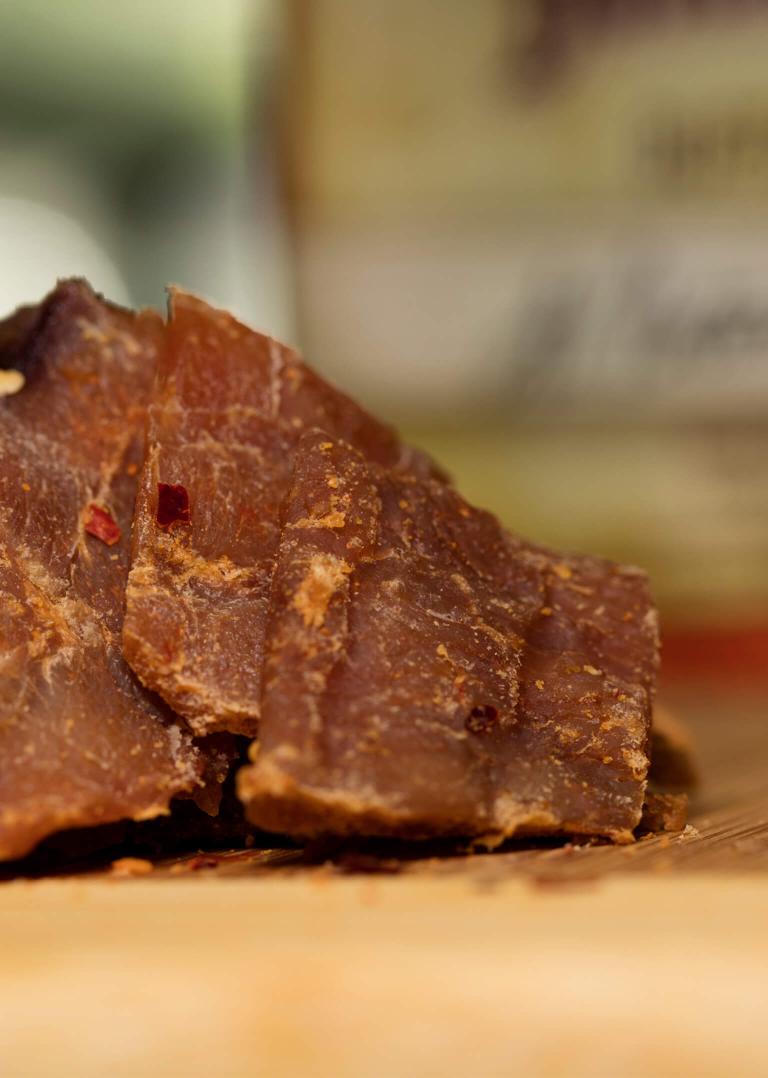
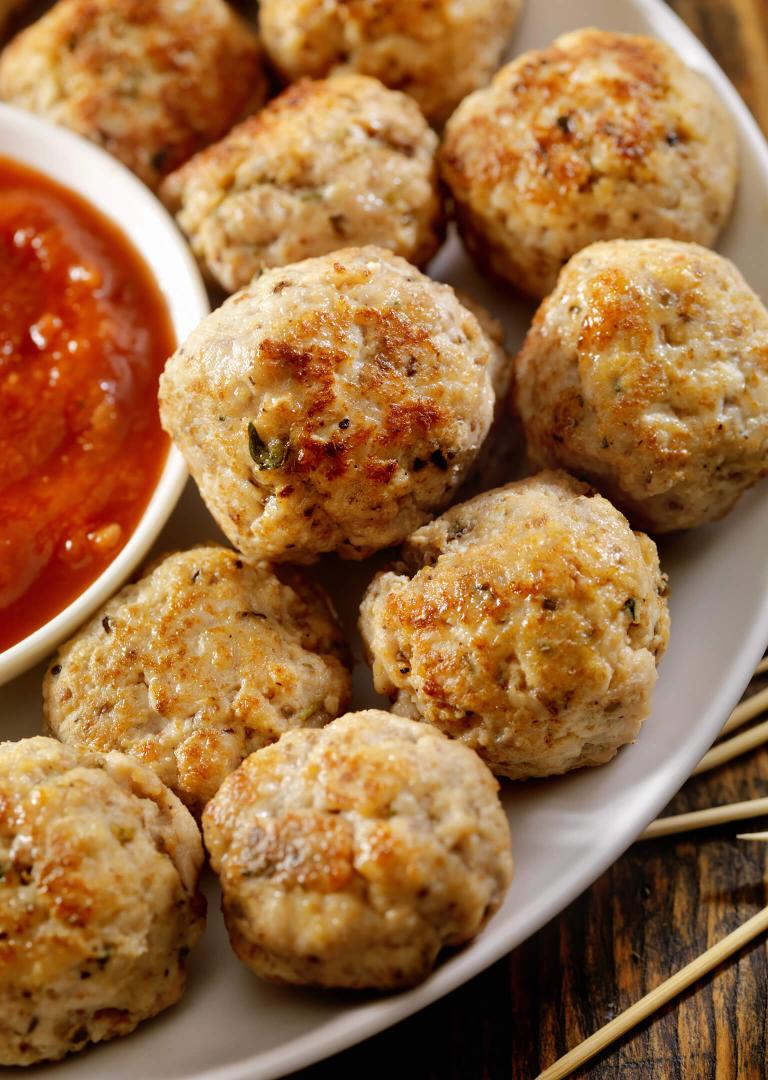


Specialized
Turkey bologna is made from turkey meat that is cured, seasoned, and mechanically separated. Turkey bologna has a similar texture to other bologna meats, and is excellent for snacks, appetizers, and as a sandwich meat.
Turkey ham comes from cured, smoked, boneless thigh meat, which varies in form or shape depending upon the method of processing or preparation.
Turkey pastrami is boneless, skinless, thigh or drumstick meat that has been ground, cured with peppercorns, and smoked.
Turkey salami is cured, all dark meat. Turkey salami contains up to 50% less fat than other salami.
Turkey bologna is made from turkey meat that is cured, seasoned, and mechanically separated. It is excellent for snacks, appetizers, and as a sandwich meat. Turkey ham comes from cured, smoked, boneless thigh meat. Turkey pastrami is boneless, skinless, thigh or drumstick meat that has been ground, cured with peppercorns, and smoked. It contains up to 50% less fat than other salami.
A healthy alternative to beef, the turkey burger is made from 100% top-grade turkey meat. Made from turkey thigh meat, this high protein, low fat product serves as an excellent alternative to traditional burgers.
A healthy alternative to beef, the turkey burger is made from 100% top-grade turkey meat. Made from turkey thigh meat, this high protein, low fat product serves as an excellent alternative to traditional burgers.
Fully cooked, ready to eat, smoked, cured turkey bacon. Simply cook to your desire of crispness and serve as a great alternative to pork bacon.
Fully cooked, ready to eat, smoked, cured turkey bacon. Simply cook to your desire of crispness and serve as a great alternative to pork bacon.
Made from whole cuts of white and dark turkey meat, turkey jerky is wholesome, nutritious, and is a good source of protein, making it a good snack for any occasion.
Made from whole cuts of white and dark turkey meat, turkey jerky is wholesome, nutritious, and is a good source of protein, making it a good snack for any occasion.
Fully cooked and lightly seasoned meatball made of top grade, tendon pulled, dark meat. A low-fat, high protein alternative to red meat.
Fully cooked and lightly seasoned meatball made of top grade, tendon pulled, dark meat. A low-fat, high protein alternative to red meat.



Preservation
Vacuum packing is used for processed, chilled, raw, and cooked turkey products. Products are packaged in synthetic bags, all air is removed, and a vacuum is formed inside the bag after packaging. In turkey preservation, the removal of oxygen reduces the growth of aerobic bacteria.
Vacuum packing is used for processed, chilled, raw, and cooked turkey products. Products are packaged in synthetic bags, all air is removed, and a vacuum is formed inside the bag after packaging. In turkey preservation, the removal of oxygen reduces the growth of aerobic bacteria.
Carbon dioxide or nitrogen gas may be introduced to assist in oxygen removal of vacuum packed turkey products without harmful effects. The key to extended shelf life of vacuum packed products is maintaining the correct temperature and an oxygen free environment. When used in turkey preservation, vacuum packed products normally have a shelf life of 10 to 14 days when maintained at 32°F (0°C), or 21 days when maintained at 28°F (-2.2°C).
Carbon dioxide or nitrogen gas may be introduced to assist in oxygen removal of vacuum packed turkey products without harmful effects. The key to extended shelf life of vacuum packed products is maintaining the correct temperature and an oxygen free environment. When used in turkey preservation, vacuum packed products normally have a shelf life of 10 to 14 days when maintained at 32°F (0°C), or 21 days when maintained at 28°F (-2.2°C).
Bulk freezing is a process of freezing the turkey product in the carton. Turkey products are frozen within 72 hours (also referred to as block frozen). Unless special individualized packaging has been used, all pieces are frozen together, and removed only when the entire container is defrosted. For the best quality, block frozen turkey products have a typical shelf life of up to 12 months if properly packaged, shipped, and stored at 0°F (-17.8°C) or below.
Bulk freezing is a process of freezing the turkey product in the carton. Turkey products are frozen within 72 hours (also referred to as block frozen). Unless special individualized packaging has been used, all pieces are frozen together, and removed only when the entire container is defrosted. For the best quality, block frozen turkey products have a typical shelf life of up to 12 months if properly packaged, shipped, and stored at 0°F (-17.8°C) or below.
Whole turkeys are most often frozen individually. This turkey preservation method cools products to approximately 0°F to 5°F (-17.8°C to -15°C), before packaging them in shipping containers with freezers cooled to 0°F (-17.8°C) or below for storage. Individually frozen turkey products are not frozen together, and each product can be removed independently while in a frozen state.
The shelf life of individually frozen turkey products is typically 12 months if the products are properly packaged, shipped, and stored at 0°F (-17.8°C) or below.
Whole turkeys are most often frozen individually. This turkey preservation method cools products to approximately 0°F to 5°F (-17.8°C to -15°C), before packaging them in shipping containers with freezers cooled to 0°F (-17.8°C) or below for storage. Individually frozen turkey products are not frozen together, and each product can be removed independently while in a frozen state.
The shelf life of individually frozen turkey products is typically 12 months if the products are properly packaged, shipped, and stored at 0°F (-17.8°C) or below.
The term “quick” frozen, as governed by the United States Department of Agriculture (USDA), requires products to be placed in a freezer immediately after initial chilling. If not frozen immediately after chilling, products may be held up to 48 hours at a temperature of 36°F (2.2°C), then frozen to 0°F (-17.8°C) or lower within 72 hours of the start of the process.
Individually quick frozen turkey parts and further processed products are rapidly frozen to approximately 0° to 5°F (-17.8° to -15°C) within 60 minutes or less of the start of the freezing process. Pieces are frozen separately, and each turkey part can be removed while in the frozen state. Individually “quick” frozen turkey products have a shelf-life of up to 12 months or more if they are properly shipped and stored at 0°F (-17.8°C) or below.
The term “quick” frozen, as governed by the USDA, requires products to be placed in a freezer immediately after initial chilling. If not frozen immediately after chilling, products may be held up to 48 hours at 36°F (2.2°C), then frozen to 0°F (-17.8°C) or lower within 72 hours of the start of the process.
Individually "quick" frozen turkey products are rapidly frozen to approximately 0° to 5°F (-17.8° to -15°C) within one hour or less of the start of the freezing process. Pieces are frozen separately so each part can be removed while in a frozen state. IQF turkey products have a shelf-life of 12 months or more if they are properly shipped and stored at 0°F (-17.8°C) or below.
This is a technique of packing some turkey products in layers interlaced with polyethylene in a manner that allows the removal of individual pieces without defrosting the entire case. Individual layer packed or honeycomb frozen turkey pieces may be thawed safely from one another without compromising the case as a whole.
This is a technique of packing some turkey products in layers interlaced with polyethylene in a manner that allows the removal of individual pieces without defrosting the entire case. Individual layer packed or honeycomb frozen turkey pieces may be thawed safely from one another without compromising the case as a whole.
The optimum shelf life for plant frozen or commercially frozen turkey products that are packaged and stored under proper conditions is normally 12 months. Testing has proven however that poultry can be stored for several years without significant loss of shelf life or flavor.
Frozen turkey products however can experience various types of damage during shipping, such as freezer burn, dehydration, chemical, or nutritional deterioration. Variables during shipping and storage that affect shelf life include not maintaining 0°F (-17.8°C) or lower temperatures, time, protection against air contamination, package rips and tears, and freezer air velocity. USAPEEC member companies make every effort to ensure frozen turkey products are stored and shipped with the utmost care.
The optimum shelf life for plant or commercially frozen turkey products that are packaged and stored under proper conditions is normally 12 months. Testing has proven however that poultry can be stored for several years without significant loss of shelf life or flavor. Frozen turkey products however can experience damage during shipping, such as freezer burn, dehydration, or nutritional deterioration. Variables during shipping and storage that affect shelf life include not maintaining 0°F (-17.8°C) or lower temperatures, time, protection against contamination, package damage, and freezer air velocity. USAPEEC member companies make every effort to ensure frozen turkey products are stored and shipped with the utmost care.
Frozen turkey and turkey products should be thawed using one of the following methods:
- Turkey may be thawed in the original packing, in a tray or pan, or in a refrigerator with a temperature no higher than 40°F (4°C). Follow the formula of 24 hours thaw time for each 4.5 pounds (2 kilograms) of turkey.
- Thaw under cold, potable running water at a temperature no higher than 50°F (10°C). Allow 30 minutes per pound for thaw time. Water volume and velocity should be enough to agitate and float all loose particles into the overflow. Note, breaded products and pre-stuffed turkeys should not be thawed in water.
- Thaw turkey products in a microwave oven as part of an uninterrupted cooking process. Turkey may also be completely cooked in a microwave and transferred to a conventional oven as part of a continuous cooking process. The turkey should be turned several times during this process, and liquid should be removed from the dish so the turkey will not cook in its own juices. The microwave power level should be reduced to medium or low when thawing turkey.
- In a conventional oven, the product may be thawed as part of an uninterrupted cooking process that starts with a frozen turkey or turkey products. Turkey giblets require careful removal midway through the roasting process.
Turkey may be thawed in the original packing, a tray or pan, or a refrigerator at 40°F (4°C) or lower. Follow the formula of 24 hours thaw time per 4.5 pounds (2 kilograms) of turkey.
Thaw under cold, potable running water at a temperature no higher than 50°F (10°C). Allow 30 minutes of thaw time per pound. Water should agitate and float all loose particles into the overflow. Breaded and pre-stuffed products should not be thawed in water.
Thaw turkey products in a microwave on medium or low as part of an uninterrupted cooking process. It may also be completely cooked in a microwave and transferred to a conventional oven as part of a continuous process. Turkey should be turned several times, and liquid should be drained from dish.
In a conventional oven, turkey may be thawed as part of an uninterrupted cooking process that starts with frozen products. Giblets require careful removal midway through the roasting process.
Depending on the portion, weight, thickness, and method of cooking, exact turkey cooking times will vary greatly. All meat of bone-in turkey and turkey products should reach 165°F (73.9°C). A meat thermometer should always be used in cooking whole turkeys or large cuts.
The thermometer should be inserted into the thickest part of the thigh muscle for a whole turkey without touching the bone. For turkey breast, the thermometer should be inserted into the thickest part of the breast. The inner thigh is the area which cooks most slowly.
Additional information on turkey food safety may be found at FoodSafety.gov.
Depending on the portion, weight, thickness, and method of cooking, exact turkey cooking times will vary greatly. All meat of bone-in turkey and turkey products should reach 165°F (73.9°C). A meat thermometer should always be used in cooking whole turkeys or large cuts.
Insert the thermometer into the thickest part of the thigh muscle for a whole turkey without touching the bone. For turkey breast, the thermometer should be inserted into the thickest part. The inner thigh is the area that cooks slowest.
Additional information on turkey food safety may be found at FoodSafety.gov.


Requests
If this is your first trade lead request, please start by adding your company’s name in our online Trade Lead Request Form. There are not any costs for using the USAPEEC Trade Lead process.
Add the details of your company, contacts and product request specifics.
After your request is submitted, the USAPEEC staff will get to work finding the appropriate supplier for your needs. The supplier will then contact you directly to start the negotiating process.
If this is your first trade lead request, please start by adding your company’s name in our online Trade Lead Request Form. There are not any costs for using the USAPEEC Trade Lead process.
Add the details of your company, contacts and product request specifics.
After your request is submitted, the USAPEEC staff will get to work finding the appropriate supplier for your needs. The supplier will then contact you directly to start the negotiating process.
Welcome back! Please start by searching our database for your company’s name, URL, or email in our online Trade Lead Request Form.
After your company is found, add your product request details and remember to update any company and contact information. Once your request is submitted, the USAPEEC staff will get to work finding the appropriate supplier for your needs. The supplier will then contact you directly.
Welcome back! Please start by searching our database for your company’s name, URL, or email in our online Trade Lead Request Form.
After your company is found, add your product request details and remember to update any company and contact information. Once your request is submitted, the USAPEEC staff will get to work finding the appropriate supplier for your needs. The supplier will then contact you directly.
Request Form Qualify
& Research Product
Request Available Supplier
Contacts You Negotiates
With You Ship
Products
USAPEEC is a trade association supported by U.S. Suppliers with the ability to fast-track your needs at no extra cost.
Please fill out all required fields.


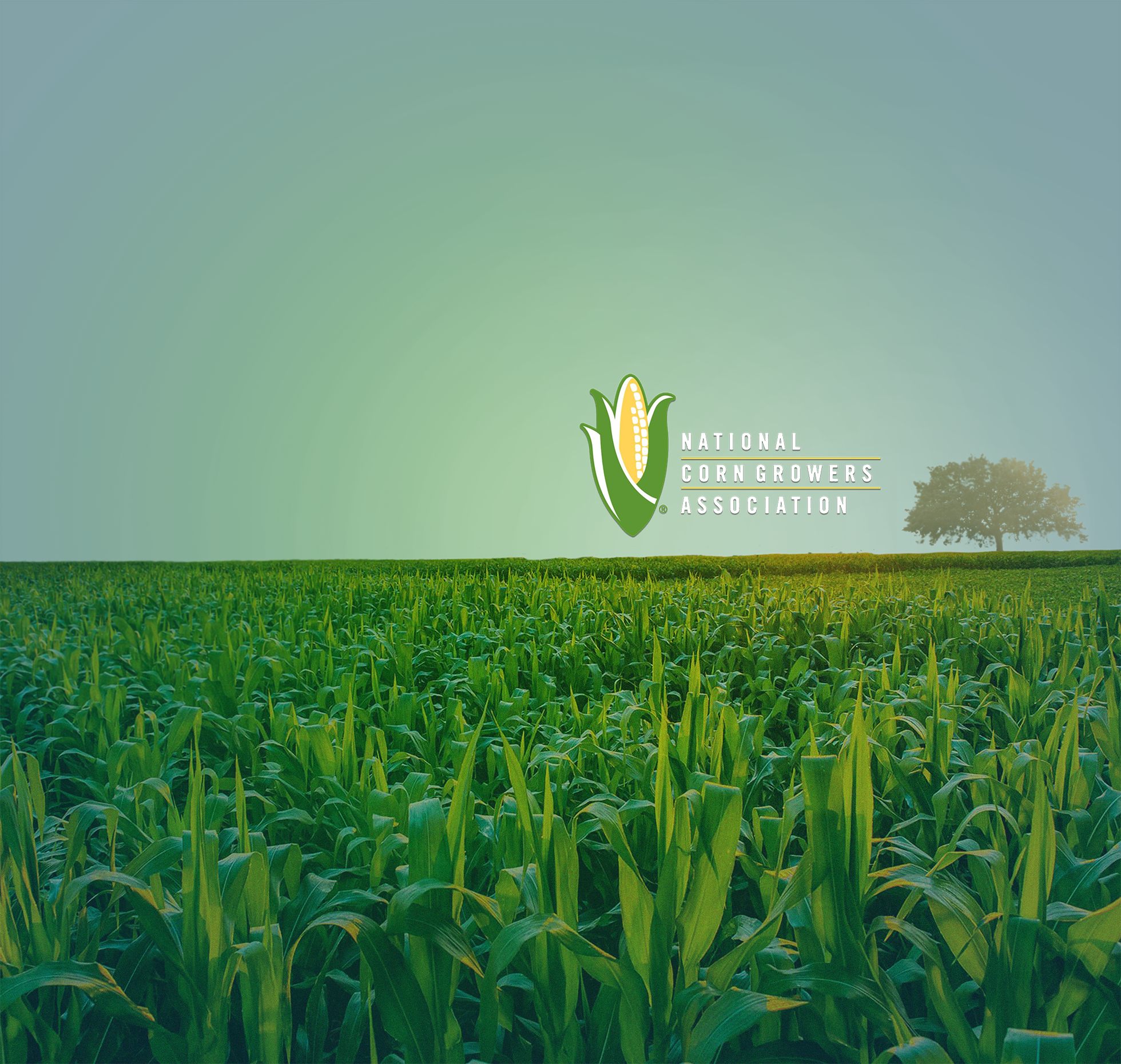
Sustainable for a Growing World
America’s corn farmers have a vested interest in sustainably feeding a growing world. We are doing this not only by working and engaging with our animal agriculture and industry allies, but also with non-traditional partners, like the Environmental Defense Fund.
Since 1980, corn farmers have diligently accomplished numerous achievements: 68 percent decrease in soil loss, 36 percent decrease in greenhouse gas emissions, and 44 percent decrease in required energy to produce a bushel of corn.
Advancements in agricultural technology have assisted the industry in doubling corn yields with fewer negative externalities on the environment. Corn yields are expected to continue to increase along with projected declines in negative environmental impacts.
America’s corn farmers have a vested interest in sustainably feeding a growing world. Since 1980, corn farmers have diligently accomplished numerous achievements: 68% decrease in soil loss, 36% decrease in greenhouse gas emissions, and 44% decrease in energy required to produce a bushel of corn.
The National Corn Growers Association (NCGA) continues to play a paramount role in the sustainability space, spearheading industry goals and continuously raising the bar for what it means to be a true steward of the land. NCGA is not only engaged with our animal agriculture partners, being a part of the U.S. Roundtable for Sustainable Beef, Dairy Sustainability Alliance, and others, but are also a part of the following initiatives:
- The Soil Health Partnership, celebrating its 5th year, is a network spanning 16 US states focused on research protocols and shared recommendations for farmers to improve productivity and sustainability specific to soil health.
- The Success in Stewardship Network, which launched in February, is a partnership with the Environmental Defense Fund to accelerate conservation practices on corn farms.
- Field to Market is an alliance bringing together supply chain stakeholders to identify opportunities to conserve soil, improve water use, and reduce energy use.
NCGA continues to play a paramount role in the sustainability space, spearheading industry goals and continuously raising the bar for what it means to be a steward of the land. NCGA is engaged with our animal agriculture partners as a part of the U.S. Roundtable for Sustainable Beef, Dairy Sustainability Alliance, as well as other initiatives.
Corn growers and the poultry industry, one of their principal customers, have had a long and mutually beneficial relationship and continue to need each other to remain profitable. Corn and its co-products, such as high protein distillers’ grains, are an excellent, economically efficient way to add valuable nutrient components to the poultry diet, including energy, protein, phosphorus, and xanthophylls.
Corn growers and the poultry industry, one of their principal customers, have had a long and mutually beneficial relationship. Corn and its co-products, such as high protein distillers’ grains, are an excellent, economically efficient way to add valuable nutrient components to the poultry diet, including energy, protein, phosphorus, and xanthophylls.
U.S. poultry consumes over 1.2 billion bushels of the approximately 14 billion bushels of corn produced annually. Through its partnership with USAPEEC, NCGA actively works through our annual carryover stocks by exporting even more corn through poultry year over year as U.S. corn farmers continue their efficiencies and yield gains.
Not only is U.S. corn affordable, sustainable, and abundant, it is also inspected and graded per the USDA Federal Grain Inspection Service Standards. Poultry buyers can rest assured that U.S. corn-fed poultry is top quality.
In the 2019-2020 Harvest Quality Report, 54.6 percent and 81.7 percent of samples met the grade requirements for U.S. No. 1 and U.S. No. 2 corn, respectively. Additionally, 99.4 percent of samples tested below the U.S. FDA action level for aflatoxin and 97.2 percent tested below 5.0 ppb.
Not only is U.S. corn affordable, sustainable, and abundant, it is also inspected and graded per the USDA Federal Grain Inspection Service Standards. Poultry buyers can rest assured that U.S. corn-fed poultry is top quality.
The National Corn Growers Association was founded in 1957 and represents 40,000 dues-paying corn farmers across the nation, as well as the interest of more than 300,000 corn growers who contribute through their states’ checkoff program. With our 50 affiliated state organizations, we work together to create and increase opportunities for corn growers while aspiring to sustainably feed an exponentially growing world.
For more information on the National Corn Growers Association, our programs, and priorities, please visit:
ncga.comThe NCGA was founded in 1957 and represents 40,000 dues-paying corn farmers across the nation, as well as the interest of over 300,000 growers who contribute through their states’ checkoff program.
ncga.com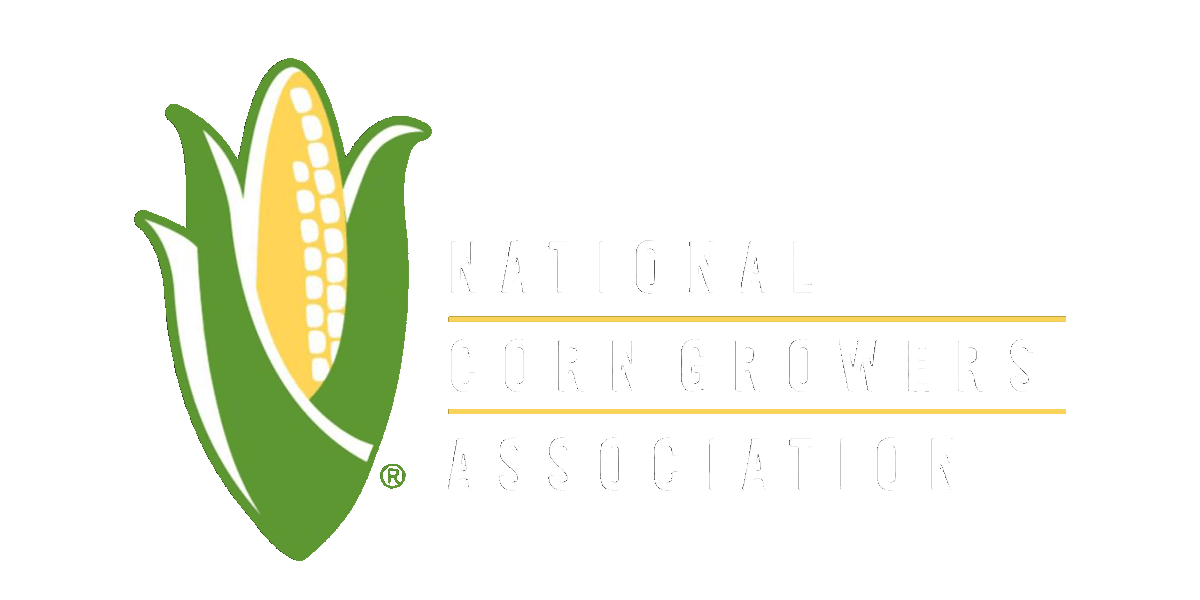


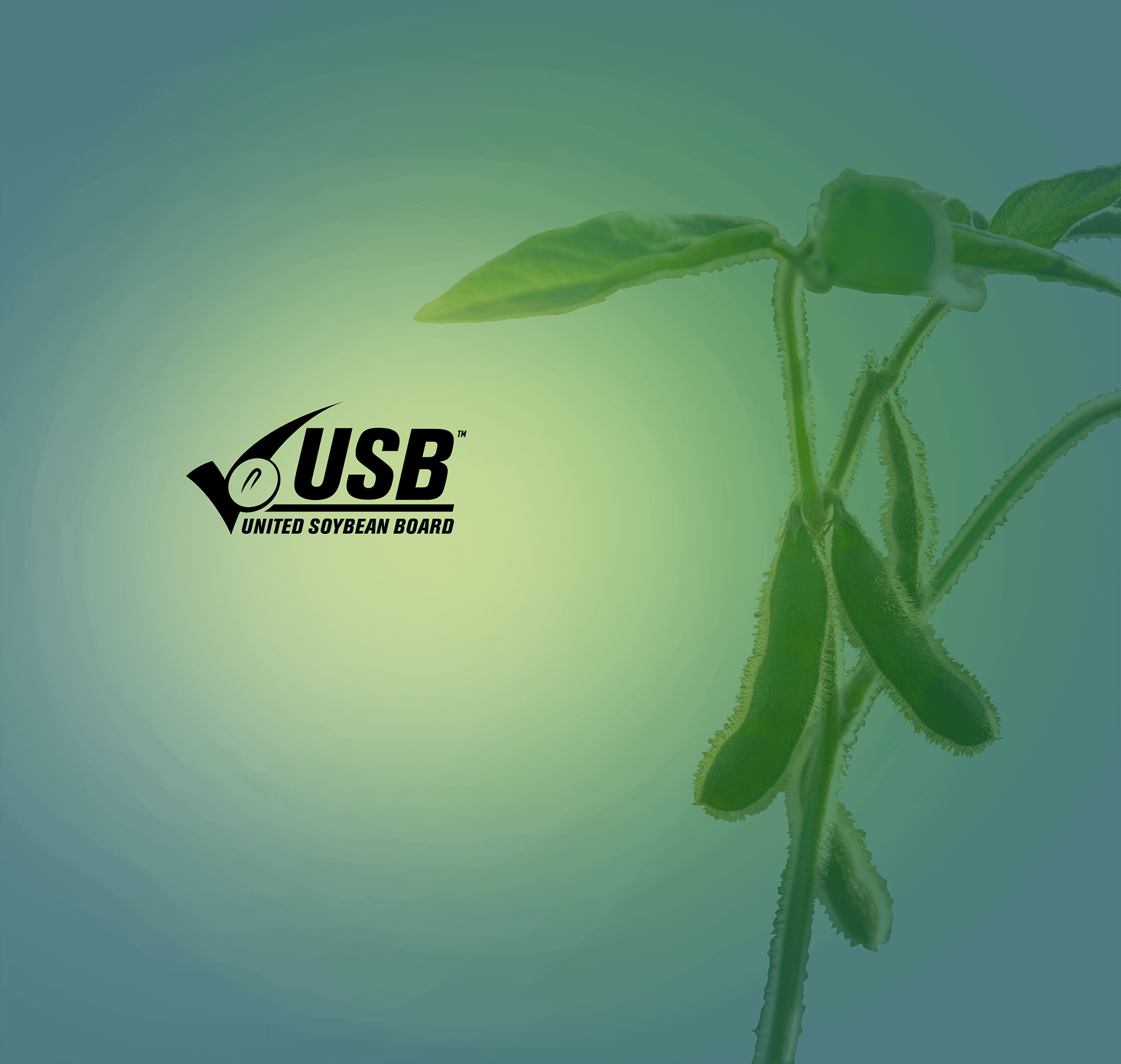
Commitment to Continuous Improvement
Recognized for its quality, composition, and myriad benefits, U.S. Soy is built on America’s soybean farmers’ commitment to continuous improvement, innovation, and sustainable growing practices. Soybean meal is a high quality option for animal feed. Its protein and range of nutritional benefits make it a popular choice for poultry diets.
Recognized for its quality, composition, and myriad benefits, U.S. Soy is built on America’s soybean farmers’ commitment to continuous improvement, innovation, and sustainable growing practices. Soybean meal is a high quality option for animal feed due to its protein and nutritional benefits.
While U.S. soybean farmers know how much pride they take in protecting both land and water resources, it is even more important to tell that story to the rest of the world. As more customers demand sustainably produced products, it is imperative that soybean farmers evaluate and consider practices that will meet those demands.
In 2015, the United Nations announced 17 Sustainable Development Goals (SDGs) to “provide a shared blueprint for peace and prosperity of people and the planet, now and into the future.” Agriculture plays an important role in addressing the SDGs, and as a global industry, U.S. Soy embraces sustainable agricultural practices, meeting today’s global needs for soy products without compromising the future. In 2019, a soy checkoff-funded initiative mapped the SDGs that connect to U.S. Soy’s priorities by using in-depth stakeholder research to understand U.S. Soy’s potential to contribute to the global UN goals.
While U.S. soybean farmers know how much pride they take in protecting both land and water resources, it is even more important to tell that story to the rest of the world. As more customers demand sustainably produced products, it is imperative that soybean farmers evaluate and consider practices that will meet those demands.
In 2015, the United Nations announced 17 Sustainable Development Goals (SDGs) to “provide a shared blueprint for peace and prosperity of people and the planet, now and into the future.” Agriculture plays an important role in addressing the SDGs, and as a global industry, U.S. Soy embraces sustainable agricultural practices, meeting today’s global needs for soy products without compromising the future. In 2019, a soy checkoff-funded initiative mapped the SDGs that connect to U.S. Soy’s priorities by using in-depth stakeholder research to understand U.S. Soy’s potential to contribute to the global UN goals.
The U.S. Soybean Sustainability Assurance Protocol (SSAP) guidelines cover today’s regulatory obligations regarding sustainable practices, but they also call for continuous improvement. Every day, U.S. soybean farmers work harder to be more efficient and environmentally sound. Along those lines, they have established continuous improvement goals for the next five years.
Based on benchmarks from 2020, by 2030, U.S. soybean producers aim to:
- Reduce the land use impact of U.S. Soy by 10 percent (calculated as planted acres per bushel)
- Reduce soil erosion in U.S. Soy production by 25 percent (calculated as tons of soil loss per acre)
- Reduce energy use in U.S. Soy production by 10 percent (calculated as BTUs per bushel)
- Reduce greenhouse gas (GHG) emissions generated in U.S. Soy production by 5 percent (calculated as pounds of CO? equivalent per bushel)
The U.S. Soybean Sustainability Assurance Protocol (SSAP) guidelines cover obligations regarding sustainable practices.Based on benchmarks from 2020, by 2030, U.S. soybean producers aim to: Reduce land-use impact by 10%, reduce soil erosion by an additional 25%, reduce energy use by 10%, and reduce greenhouse gas emissions by 5%.
U.S. soybean meal’s high quality composition has long been prized by feed manufacturers and formulators. All quality indicators of soybean meal, such as crude protein, crude fiber, neutral detergent fiber, sugars, and amino acid profiles, should be taken into account by purchasers to determine the meal’s true value. Recently, a meta-analysis looked at 18 different studies and 1,944 samples of soybeans from Argentina, Brazil, India, and the United States to quantify the relationship between the country of origin and the chemical composition, protein quality, and nutritive value of the resulting soybean meal. The data from this study were then processed by the Nutrient Value Calculator (NVC), a software tool constructed by Genesis Feed Technologies. This cost analysis supported the economic benefits of U.S. soybean meal relative to meal from other origins as a key ingredient in poultry rations.
U.S. soybean meal’s high quality composition has been prized by feed manufacturers/formulators. Quality indicators of soybean meal, such as crude protein, crude fiber, neutral detergent fiber, sugars, and amino acid profiles, should be taken into account to determine the meal’s true value.
The United Soybean Board’s 78 volunteer farmer-directors work on behalf of all U.S. soybean farmers to achieve maximum value for their soy checkoff investments. These volunteers invest and leverage checkoff funds in programs and partnerships to drive soybean innovation beyond the bushel and increase preference for U.S. Soy. That preference is based on U.S. soybean meal and oil quality and the sustainability of U.S. soybean farmers. As stipulated in the federal Soybean Promotion, Research and Consumer Information Act, the USDA Agricultural Marketing Service has oversight responsibilities for USB and the soy checkoff.
For more information on the United Soybean Board, visit:
unitedsoybean.orgThe United Soybean Board’s 78 volunteer farmer-directors work on behalf of all U.S. soybean farmers to achieve maximum value for their soy checkoff investments. For more information, visit:
unitedsoybean.org